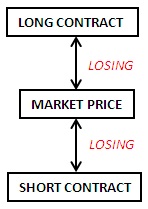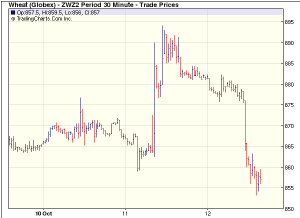WEEK 6 RECAP
I finally managed to take advantage of the wheat prices fluctuation, and offset both contracts with a slight gain after keeping them in the market for 3 weeks. The short contract (W2Z) was offset first at the beginning of the week, while the price was low, and I set a price limit on the long contract (W3H), which was triggered after wheat price rebounded.
End of Week 6 Balance: $40668.59
***
WEEK 7
HOW I MEANT TO PLAY THE GAME… Both corn and wheat futures prices spiked for two days straight at the end of week 6; I was certain that commodity future prices would drop for the first half of the week, and rebound during the latter half. Given my prediction for the next few days, my initial plan was to go SHORT on several wheat and corn contracts early on Monday (Oct 22nd) morning, and offset them before the market closes on Tuesday (Oct.23rd). Perhaps, wait for a day, to re-enter the market with a few LONG contracts for both commodities, given that corn and wheat would rebound after the drop from Monday, and Tuesday. I would then offset all of my long contracts before the market closes on Friday, and keep no contracts in the market over the weekend.
WHAT REALLY HAPPENED? Tradesim didn’t allow my week to go as planned. I set up a few price limit orders for 3 SHORT wheat contracts, and 1 SHORT corn contract on Monday morning. Based on the price record from CME, it was clear that both wheat and corn future prices went above the price limits that I’ve set on Monday. However, Tradesim failed to trigger my price limit orders, and none of the contracts were executed. I became frustrated after I saw the prices for both commodities started to show signs of dropping on Monday night, and resent my orders with market orders. While they did get processed the next day, Tradesim lagged, and my orders weren’t processed until right before the market closed on Tuesday. By then, the prices have already hit their limit down, and started to rebound. As a result, even though corn and wheat commodity prices were dropping for the entire Tuesday, my total gain was negative due to my low “price in” prices. I essentially went SHORT after the future prices were finished descending. Knowing that I wasn’t going to make any gains with both commodities’ price patterns going upward; I sent in another 4 price limit orders, and set the prices just below my “price-ins”, to allow the contracts to automatically offset themselves once the commodity prices decrease again.
HOW THE WEEK ENDED… After Ukraine had confirmed a ban on exports of wheat on Wednesday, both corn and wheat future prices spiked. I was potentially losing a total of $2962.00, and 3 of the contracts were receiving margin calls. None of the price limit orders were triggered, because the prices went the opposite direction. Fortunately, spiked prices were responded by a drop on Thursday; corn price dropped low enough that the price limit order managed to offset the contract, and I earned $174.00. My potential loss for the 3 SHORT wheat contracts has also decreased to $1312.00, and the margin calls were cancelled. Commodity futures prices continued to drop on Friday, and the price limit for 2 of the SHORT wheat contracts were triggered. I managed to earn $61.50 for each contract, which total up to be 2*$61.50 = $123.00. As of Friday, my potential loss for W3H SHORT contract is $200.00.
End of Week 6 Balance: $40765.34
It appears that Tradesim has been having difficulty processing my orders at the time that I intended them to, and I always ended up entering the market after the predicted prices have completed fluctuating. As a result, the prices usually have already started to move in the opposite direction by the time my contracts are in. I wonder if it would be better to just do the opposite of where I think the prices are going to go, and take the lagging period into consideration when making trading decisions.

















